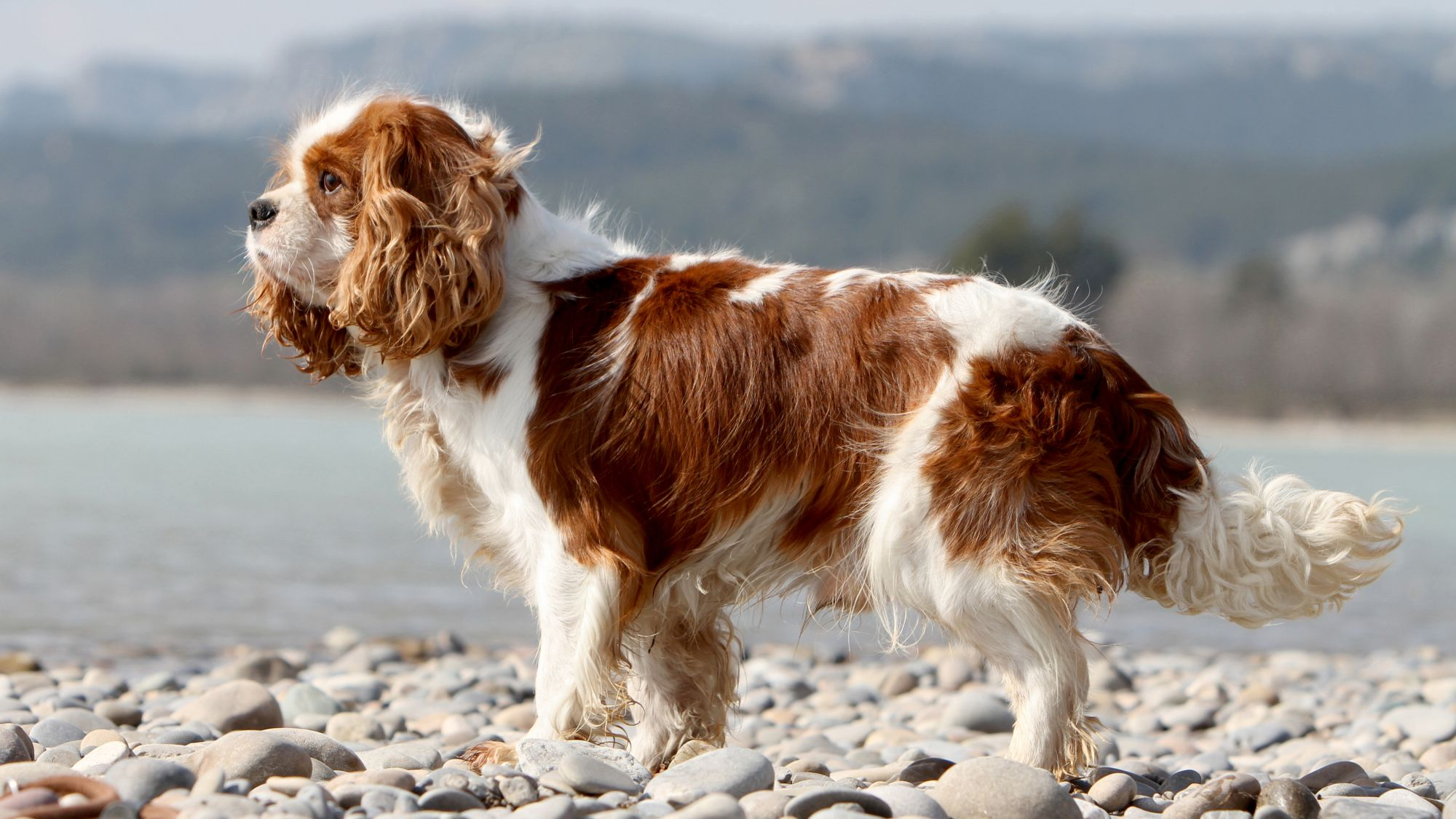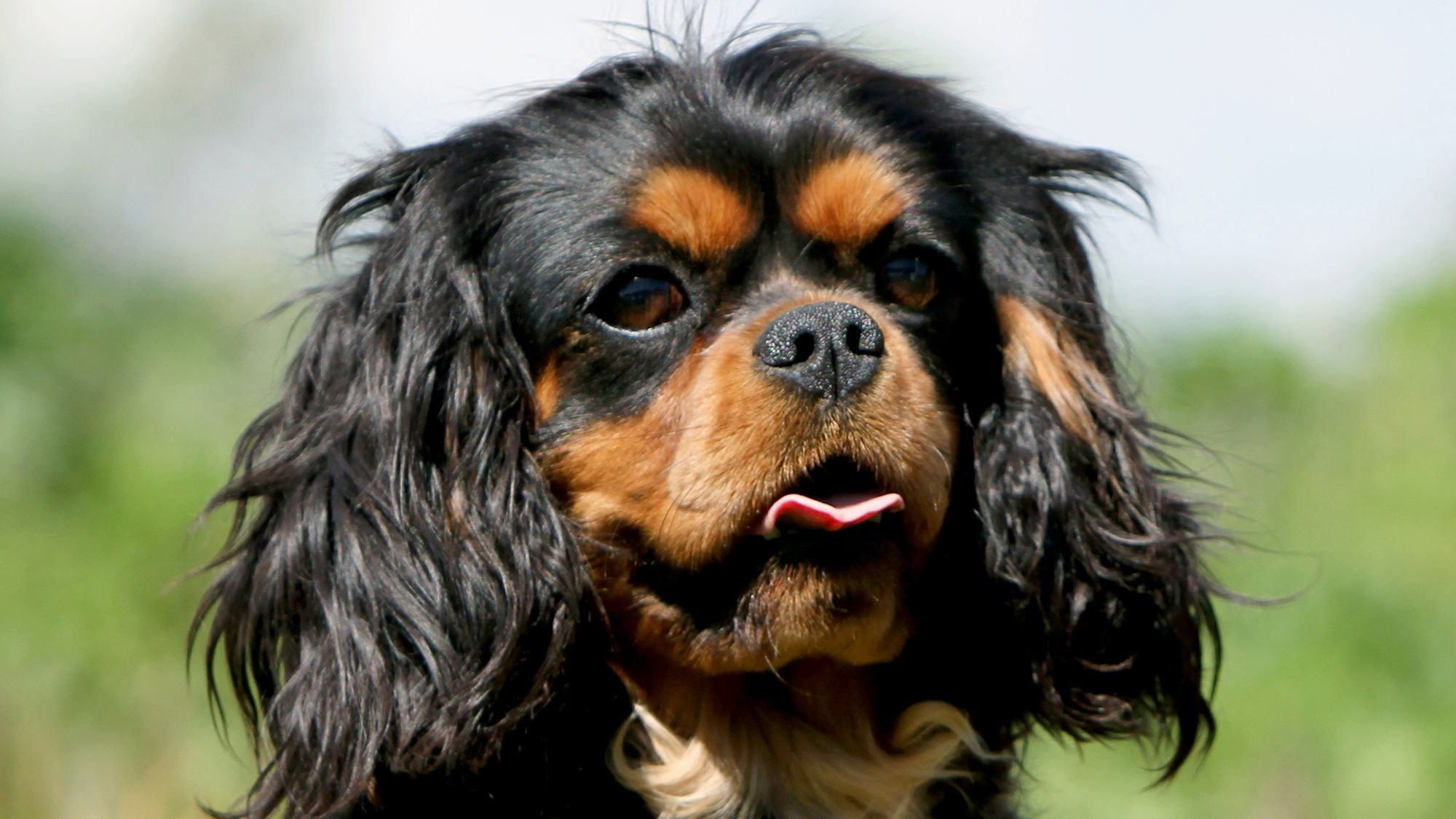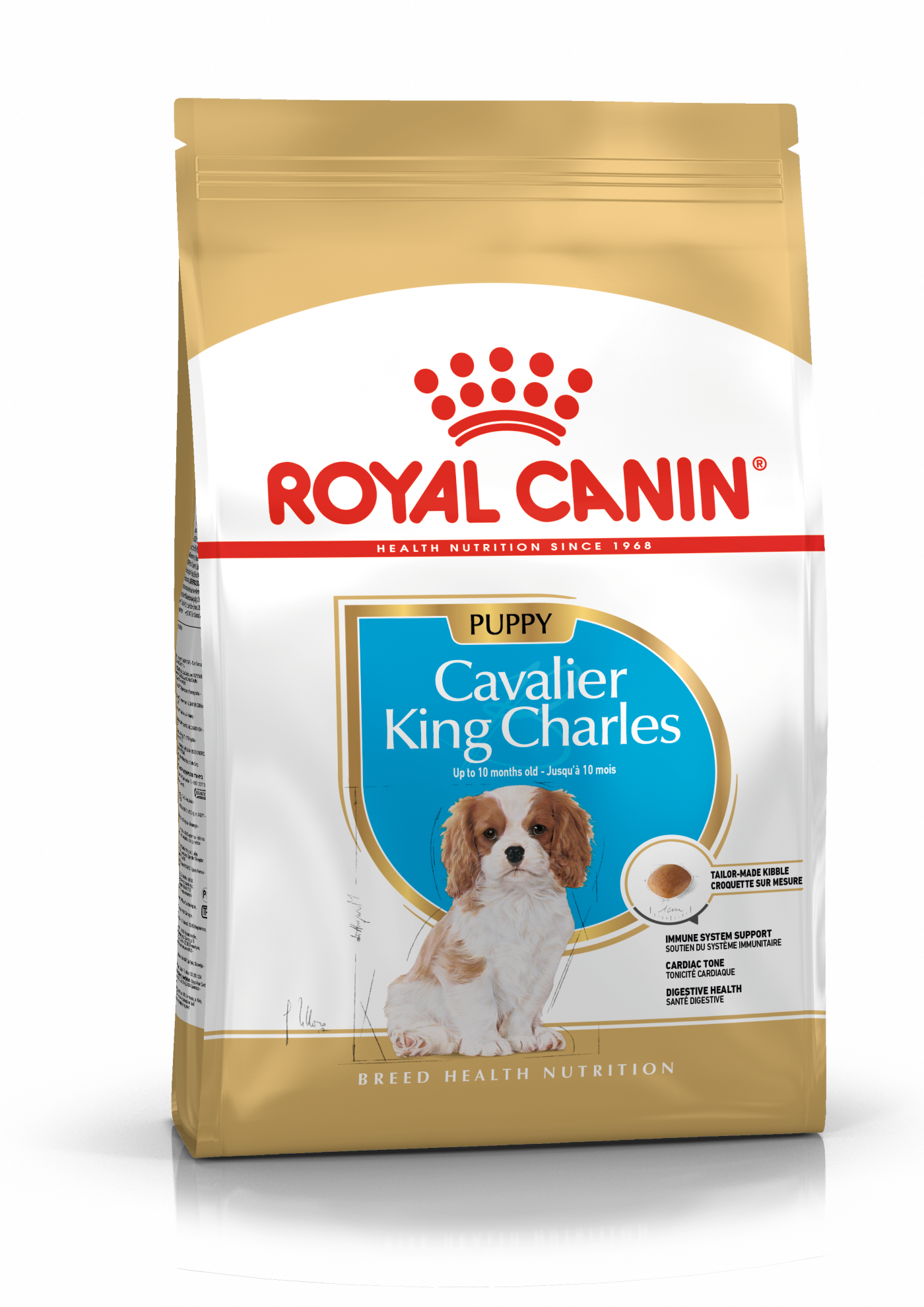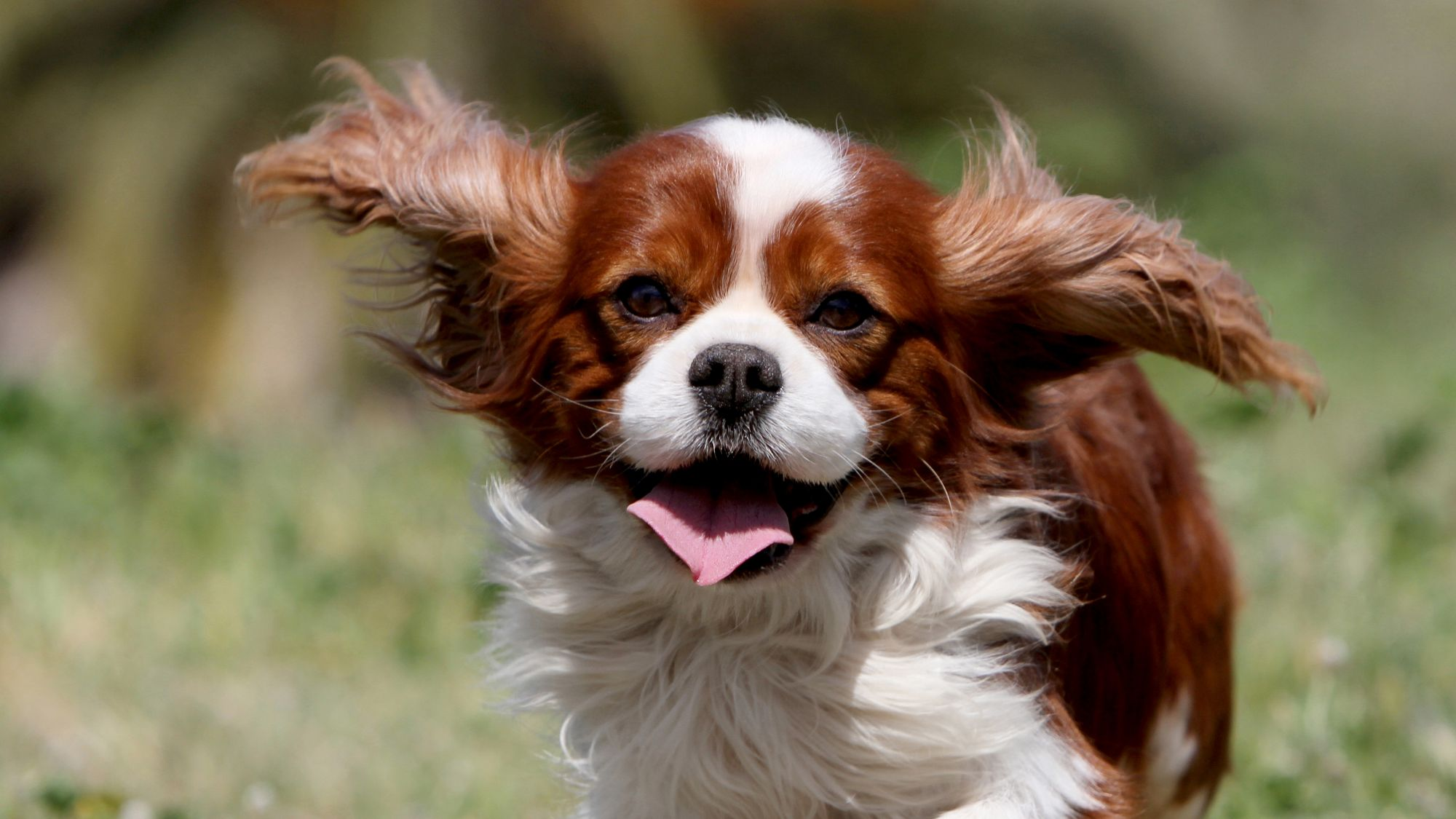Cavalier King Charles Spaniel - Breed Facts & Characteristics
While they may be small in size, these daring little dogs pack a punch much bigger than you might think. Often quite fearless, Cavalier King Charles Spaniels are curious about everything around them and can be surprisingly sporty (they are a spaniel, after all). At the same time, they are also very affectionate and form strong bonds with their human owners. Famed for their silky locks, droopy ears and expressive eyes, the Cavalier King Charles Spaniel must surely be one of the top tail-waggers too.
Official name: Cavalier King Charles Spaniel
Other names: Cavie, English Toy Spaniel
Origins: Great Britain
Tendencia a babear
{score 0 out of 5}Necesidades de aseo
{score 0 out of 5}Nivel de muda de pelo:
{score 0 out of 5}Tendencia a ladrar
{score 0 out of 5}Nivel de energía
{score 0 out of 5}Compatibilidad con otras mascotas
{score 0 out of 5}¿Clima cálido?
{score 0 out of 5}¿Clima frío?
{score 0 out of 5}Apto para vivir en departamento
{score 0 out of 5}Puede quedarse solo
{score 0 out of 5}¿Mascota familiar? *
{score 0 out of 5}
| Macho | Hembra |
|---|---|
| Altura | Altura |
| 30.5 - 33 | 30.5 - 33 |
| Peso | Peso |
| 5.4 - 8 | 5.4 - 8 |
| Cachorro | Adulto |
|---|---|
| 2 to 10 months | 10 months to 8 years |
| Madurez | Adulto mayor |
| 8 to 12 years | 12 to 20 years |
| Bebé | |
| Birth to 2 months | |
Tendencia a babear
{score 0 out of 5}Necesidades de aseo
{score 0 out of 5}Nivel de muda de pelo:
{score 0 out of 5}Tendencia a ladrar
{score 0 out of 5}Nivel de energía
{score 0 out of 5}Compatibilidad con otras mascotas
{score 0 out of 5}¿Clima cálido?
{score 0 out of 5}¿Clima frío?
{score 0 out of 5}Apto para vivir en departamento
{score 0 out of 5}Puede quedarse solo
{score 0 out of 5}¿Mascota familiar? *
{score 0 out of 5}
| Macho | Hembra |
|---|---|
| Altura | Altura |
| 30.5 - 33 | 30.5 - 33 |
| Peso | Peso |
| 5.4 - 8 | 5.4 - 8 |
| Cachorro | Adulto |
|---|---|
| 2 to 10 months | 10 months to 8 years |
| Madurez | Adulto mayor |
| 8 to 12 years | 12 to 20 years |
| Bebé | |
| Birth to 2 months | |

Get to know the Cavalier King Charles Spaniel
All you need to know about the breed
Always ready with a wag of their long, swishy tails, Cavalier King Charles Spaniels are renowned for their sweet and gentle temperament. As one of the smaller breeds of spaniel, they adapt well to most domestic set-ups and will quickly become an integral member of the family. Once trained, Cavalier King Charles Spaniels are usually great with children and other animals too.
To understand the origins of the Cavalier King Charles Spaniel, we need to go back in time to the 1500’s when toy spaniels were first seen in Europe – having possibly been brought over from East Asia. Later, in the 17th century, these diminutive dogs became a favourite of King Charles I and his son, Charles II, resulting in the subsequent moniker (their handler did not cast the widest net when renaming the breed). However, it wasn’t until the 1920’s that the Cavalier King Charles Spaniel emerged as a distinct breed in its own right.
Now one of the most popular types of spaniel, the Cavalier King Charles Spaniel was given a further boost when the hit HBO series, Sex and the City, was broadcast. Fans of the show will recall that Charlotte’s dog was a Cavalier King Charles Spaniel memorably called Princess Dandyridge Brandywine – a fine name for a dog.
Long admired for their soft silky coat, the Cavalier King Charles Spaniel comes in four distinct colour patterns – with variations of chestnut, white, black, tan and red – or Blenheim, Tricolour, Ruby and Black & Tan, to give them their proper names. What all Cavalier King Charles Spaniels share in common, though, is that feathered fur, long droopy ears and large, expressive brown eyes.
Also quite adaptable little dogs, they are as content curled up on the sofa with their human owners as they are out on a walk. With a longish lifespan, and a top age of 20, the Cavalier King Charles Spaniel is an excellent choice of companion all-round.

2 facts about Cavalier King Charles Spaniels
1. A right royal history
The regal origins of the Cavalier King Charles Spaniel have not been forgotten down the centuries. As well as the ‘King Charles’ part of the name, the ‘Cavalier’ precursor stems from the term used for Royalist supporters of Charles I during the English Civil War.
2. In the frame
Another well-known fan of the Cavalier King Charles Spaniel was the glamorous Hollywood star Lauren Bacall. Rumour has it that the actress was so devoted to her own Cavalier King Charles Spaniel that she had a portrait of her beloved dog hung in her home.
History of the breed
When it comes to the history of the Cavalier King Charles Spaniel, the clue is in the name. Back in the 17th-century, King Charles I and his son, Charles II, became big fans of toy spaniels – so much so that the ‘King Charles Spaniel’ was named after the pair. In fact, the diarist Samuel Pepys famously wrote that Charles II seemed more interested in his spaniels than ruling the country.
The King Charles breed continued to be popular into the early 19th century – boosted by the Marlborough family, at Blenheim Palace, who bred their own line of red-and-whites. But then, in Victorian times, dog fanciers began crossing them with similar Asian breeds. This resulted in a more dome-shaped skull and a flatter face.
However, the original toy spaniel breed still featured in many of the old family portraits from the time, and in the 1920’s, a wealthy American called Roswell Eldridge laid down a challenge. If any British breeders could produce spaniels of the ‘Old World type’, he would offer a cash prize. Not surprisingly, that had the desired effect and this ‘new’ type of toy spaniel was named the Cavalier King Charles Spaniel.
The breed was given formal recognition by the British Kennel Club in 1945 – though was only accepted in America as recently as 1996. Nowadays, Cavalier King Charles Spaniels are a favourite on both sides of the pond.
From head to tail
Physical characteristics of Cavalier King Charles Spaniels
1.Coat
2.Colouring
3.Head
4.Face
5.Body

Things to look out for
From specific breed traits to a general health overview, here are some interesting facts about your Cavalier King Charles Spaniel
This is a breed that can suffer from respiratory issues
With the right care, the Cavalier King Charles Spaniel can often be a healthy dog well into old age – but one thing to bear in mind is that they belong to the ‘brachycephalic’ family. This means that their physical features include a flat face and short nose, due to the shape of their skull, and these anatomical attributes can cause some potential health issues. For example, Cavalier King Charles Spaniels can occasionally suffer with breathing problems. For this reason, as with all brachycephalic breeds, we advise you to choose a dog with physical features that are not over-exaggerated, to buy from a responsible breeder and to seek counsel from your vet if needed.
Be sure to keep a look-out for any eye problems
Another thing to be aware of with the Cavalier King Charles Spaniel is that they can be susceptible to issues with their sight. In fact, according to some estimates, Cavaliers are twice as likely as other breeds to need treatment for eye conditions. Some of these are hereditary such as microphthalmos (an abnormally small eye); others are congenital like keratoconjunctivitis sicca (a reduction in tear production); and then there’s those that are acquired such as cataracts (due to old age or diabetes). But no need to panic as many conditions can be treated successfully. As always, early detection is key, so monitor any changes in your Cavalier King Charles Spaniel and book in regular check-ups with your vet.
Like many small breeds of dog, they can be prone to dental issues
In particular, gingivitis is a common problem in the Cavalier King Charles Spaniel. An inflammation of the gums that is caused by plaque, it can also lead on to gum recession and periodontal disease. The latter occurs when the minerals (calcium) in the saliva deposit on the plaque and form tartar. That, in turn, allows the bacteria to thrive and cause more inflammation. We won’t dwell on the bad breath... Daily brushing is the best way to remove plaque, so be sure to stick to it. Regular dentistry checks will also help to keep their mouth healthy. Finally, a good diet can go a long way too. For example, special dental kibbles have the benefit of a mechanical cleaning action – and calcium ‘chelators’ will help prevent the build-up of tartar.
Healthy diet, healthier dog

When choosing food for a Cavalier King Charles Spaniel, there are many factors to consider: their age, lifestyle, activity level, physiological condition, and health including potential sickness or sensitivities. Food provides energy to cover a dog’s vital functions, and a complete nutritional formula should contain an adjusted balance of nutrients to avoid any deficiency or excess in their diet, both of which could have adverse effects on the dog.
Clean and fresh water should be available at all times to support your dog’s urinary health. In hot weather and especially when out exercising, bring water along for your dog’s frequent water breaks.
The following recommendations are for healthy animals. If your dog has health problems, please consult your veterinarian who will prescribe an exclusive veterinary diet.
A Cavalier King Charles Spaniel puppy’s requirements, in terms of energy, protein, minerals and vitamins, are much greater than those of an adult dog. They need energy and nutrients to maintain their body, but also to grow and build it. Until they are 10 months old, a Cavalier King Charles Spaniel puppy's immune system develops gradually. A complex of antioxidants - including vitamin E - can help support their natural defences during this time of big changes, discoveries, and new encounters. Their digestive functions are different from an adult Cavalier King Charles’ Spaniel, too: their digestive system is not mature yet so it’s important to provide highly digestible proteins that will be effectively used. Prebiotics such as fructo-oligosaccharides, support digestive health by helping balance the intestinal flora, resulting in good stool.
Similarly, a puppy’s teeth – starting with the milk teeth, or first teeth, then the permanent teeth – are an important factor that needs to be taken into account when choosing the size, form, and hardness of kibble. A formula that contains calcium chelators will help reduce tartar formation. To help support good cardiac function, look for an adjusted mineral content, EPA-DHA, taurine, L-carnitine, and antioxidants in the formula. This intense growth phase also means high energy needs, so the food must have a high energy content (expressed in Kcal/100g of food), while concentrations of all other nutrients will also be higher than normal in a specially formulated growth food. It is recommended to split the daily allowance into three meals a day until they are six months old, then to switch to two meals per day.

The main nutritional goals for adult Cavalier King Charles Spaniels are:
Helping support good cardiac function with an adjusted content of minerals, EP-DHA, taurine, L-carnitine, and antioxidants.
Maintaining an ideal body weight by using highly digestible ingredients and keeping the fat content at a sensible level.
Preserving the health and beauty of the skin and coat with the enriched addition of essential fatty acids (especially EPA-DHA) and borage oil.
At adult age, small breed dogs are exposed to oral and dental disorders, more precisely accumulation of dental plaque and tartar. The Cavalier King Charles Spaniel's teeth and jaws need a lot of protection. A special kibble shape and a texture designed to promote chewing can help in slowing down the formation of dental plaque, and a formula containing calcium chelators will help reduce tartar formation, hence helping to support daily oral hygiene. Small breed dogs are well known for being fussy eaters. Exclusive formula and flavourings, as well as a kibble size with a special texture, will stimulate their appetite. Small breed dogs can be prone to urinary stones; a diet that also helps support a healthy urinary system is recommended to prevent urinary stones.
For Cavalier King Charles Spaniels living mainly indoors, highly digestible proteins, an appropriate fibre content, and very high-quality carbohydrate sources will help reduce faecal smell and volume. Because an indoor lifestyle often means less exercise, an adapted calorie content, which meets the reduced energy needs, and a diet that contains L-carnitine, which promotes fat metabolism, can help maintain an ideal weight. It is important to avoid feeding them human foods or fatty snacks. Instead, reward your dog with kibble taken from their daily meal allowance, and strictly follow the feeding guidelines written on the package in order to prevent excessive weight gain.

After 8 years old, Cavalier King Charles Spaniels start facing the first signs of ageing. A formula enriched with antioxidants will help maintain their vitality and an adapted phosphorus content will support their renal system. Ageing is also accompanied by the modification of digestive capacities and particular nutritional requirements, so food for older Cavalier King Charles should have the following characteristics:
Higher vitamin C and E content. These nutrients have antioxidant properties, helping to protect the body’s cells against the harmful effects of the oxidative stress linked to ageing
An adjusted content of minerals, EPA-DHA, taurine, L-carnitine, and antioxidants to help support good cardiac function
High-quality protein. Contrary to a widely held misconception, lowering the protein content in food brings little benefit in limiting kidney failure because older dogs are less efficient at using dietary protein than younger dogs. Reducing the phosphorus content is a good way of slowing down the gradual deterioration of kidney function
A higher proportion of the trace elements iron, zinc and manganese to maintain good condition of the skin and coat.
A higher quantity of polyunsaturated fatty acids, like borage oil and fish oil, to help maintain the quality of the coat. Dogs normally produce these fatty acids, but ageing can affect this physiological process.
As they age, dogs increasingly suffer from teeth problems. To ensure they continue to eat in sufficient quantities, the shape, size, and hardness of their kibble needs to be tailored to their jaw.

Caring for your Cavalier King Charles Spaniel
Grooming, training and exercise tips
Despite being bred as lap dogs, this is a breed that descends originally from more sporty spaniels. As some of that spirit remains today, Cavalier King Charles Spaniels still require a reasonable amount of daily exercise – ideally up to an hour in total. They will always appreciate a nice long walk with their owners, but other activities can include games, training and a good sniff around in the park. As Cavalier King Charles Spaniels can also be prone to a bit of weight gain as they age, it’s especially important that they get their daily allocation of physical activity – and this will also help to keep them mentally stimulated.
The lustrous coat of the Cavalier King Charles Spaniel is actually quite deceptive – in a good way! Silky, smooth and moderately long, it’s often assumed to be fairly high-maintenance. In fact, the Cavalier King Charles Spaniel should be fine with a weekly brushing and the occasional bath. Just keep an eye out for any matting in-between times and be prepared for a little more brushing during shedding times. The Cavalier King Charles Spaniel will also need their nails trimmed as often as needed and their long drop ears should be checked weekly for any sign of infection. As they can also be prone to dental issues, teeth-brushing at home is a must and regular check-ups are recommended.
As well as their calm temperament, Cavalier King Charles Spaniels are naturally intelligent and quick learners. This makes the training process smooth for both dog and owner alike. Eager to please, they will respond well to praise – and, yes, especially to foodie treats. If you go down this route, it’s best to reward them with kibbles from their daily allocation rather than unhealthy snacks. Beyond puppy training, Cavalier King Charles Spaniels also tend to do well in obedience, rally and agility classes. Their gentle and affectionate personalities, and the fact the Cavalier King Charles Spaniels have few behaviour problems, also makes them excellent therapy dogs too.
Despite being bred as lap dogs, this is a breed that descends originally from more sporty spaniels. As some of that spirit remains today, Cavalier King Charles Spaniels still require a reasonable amount of daily exercise – ideally up to an hour in total. They will always appreciate a nice long walk with their owners, but other activities can include games, training and a good sniff around in the park. As Cavalier King Charles Spaniels can also be prone to a bit of weight gain as they age, it’s especially important that they get their daily allocation of physical activity – and this will also help to keep them mentally stimulated.
The lustrous coat of the Cavalier King Charles Spaniel is actually quite deceptive – in a good way! Silky, smooth and moderately long, it’s often assumed to be fairly high-maintenance. In fact, the Cavalier King Charles Spaniel should be fine with a weekly brushing and the occasional bath. Just keep an eye out for any matting in-between times and be prepared for a little more brushing during shedding times. The Cavalier King Charles Spaniel will also need their nails trimmed as often as needed and their long drop ears should be checked weekly for any sign of infection. As they can also be prone to dental issues, teeth-brushing at home is a must and regular check-ups are recommended.
As well as their calm temperament, Cavalier King Charles Spaniels are naturally intelligent and quick learners. This makes the training process smooth for both dog and owner alike. Eager to please, they will respond well to praise – and, yes, especially to foodie treats. If you go down this route, it’s best to reward them with kibbles from their daily allocation rather than unhealthy snacks. Beyond puppy training, Cavalier King Charles Spaniels also tend to do well in obedience, rally and agility classes. Their gentle and affectionate personalities, and the fact the Cavalier King Charles Spaniels have few behaviour problems, also makes them excellent therapy dogs too.
7/7
All about Cavalier King Charles Spaniels
Though they share much in common, the King Charles Spaniel and the Cavalier King Charles Spaniel are two distinct breeds. There are two important ways in which you can tell the difference. As well as the fact that the King Charles Spaniel is slightly smaller in size than the Cavalier King Charles Spaniel, they also have a notably shorter muzzle and a different shaped head.
The easy-going temperament of the Cavalier King Charles Spaniel means they are a very docile breed and not one to kick up a fuss generally. However, there is one exception to this. As they form strong bonds with their human owners, the Cavalier King Charles Spaniel does not do well alone and can be prone to separation anxiety. If this occurs, they will often bark persistently until reunited with their ‘pack leader’.
Other breeds that might interest you
Read more on this topic
Sources
- Veterinary Centers of America https://vcahospitals.com/
- Royal Canin Dog Encyclopaedia. Ed 2010 and 2020
- Banfield Pet Hospital https://www.banfield.com/
- Royal Canin BHN Product Book
- American Kennel Club https://www.akc.org/
Like & share this page